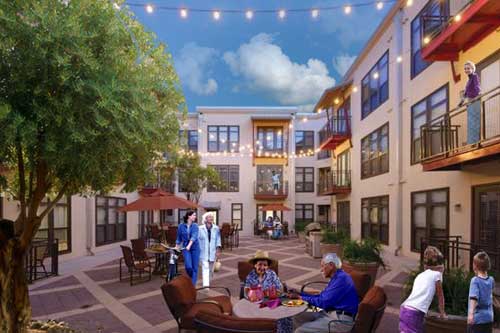Connecting or bringing together Non-Profit and For-Profit Website Links of Housing, Education, Community and Care Provider Resources under one portal to help Specific Communities Live-and-Age Connected in Community.
ANYTOWN, USA.
ANYTOWN, USA.
Most older adults, overwhelmingly (82 percent), want to stay in their communities through retirement.
By 2030, 1 in four residents will be 60 or older increase with a 94% increase among people 75+ and a 34% increase among people 90+.
Prior to today, organizations worked to develop programs for older adults by funding construction of senior centers and the purchase of equipment plus provide free or affordable nutritious meals in central locations.
Today, many organizations’ priorities include helping communities become more age-friendly and enabling older adults and people with disabilities to remain in their homes for as long as they desire. That vision promotes vibrant, connected, lifelong communities with a broad spectrum of housing, transportation and employment, complemented by connected resources.
Fiscal analysis shows that keeping seniors in their homes for as long as possible saves them — and the rest of us — significant amounts of money. And we know from experience that our communities are stronger and more resilient when they include elders.
Source: DRCOG (Area Agency on Aging)
The number of people involved in care for older family members is growing along with the increasing population of older adults. We will need to sharpen our strategies for supporting spouses, family and caregivers.
There are many agencies working on behalf of older adults and people with disabilities. Combined efforts within the nonprofit, government and private sectors represent countless organizations and individuals working toward a common goal of allowing residents to age with choice.
There’s no silver bullet for the challenge of meeting a growing population of older adults’ unmet needs. It’s no single organization’s responsibility to advocate on behalf of, provide education on the issues around and increase funding for older adults and people with disabilities. Rather, by leveraging and coordinating the strength of everyone's contributions we will succeed in making our communities as age-friendly as possible.
Everyone needs to continue to work to identify gaps in service among various populations. Older adults want to stay in their homes and communities. And if the right resources are available to help them do so, it costs much less for them, their families and the state’s taxpayers. The fastest way for the region to achieve its goal of keeping older adults independent and at home for as long as they choose is to increase the variety and availability of community-based services. Whether it is financial matters, lack of nutrition or trying to find access to transportation, the challenges facing some segments of older adults can be minimized as individuals and organizations work together to make those resources accessible.

EXAMPLE OF COMPANIES THAT LINK WITHIN THE PORTAL: